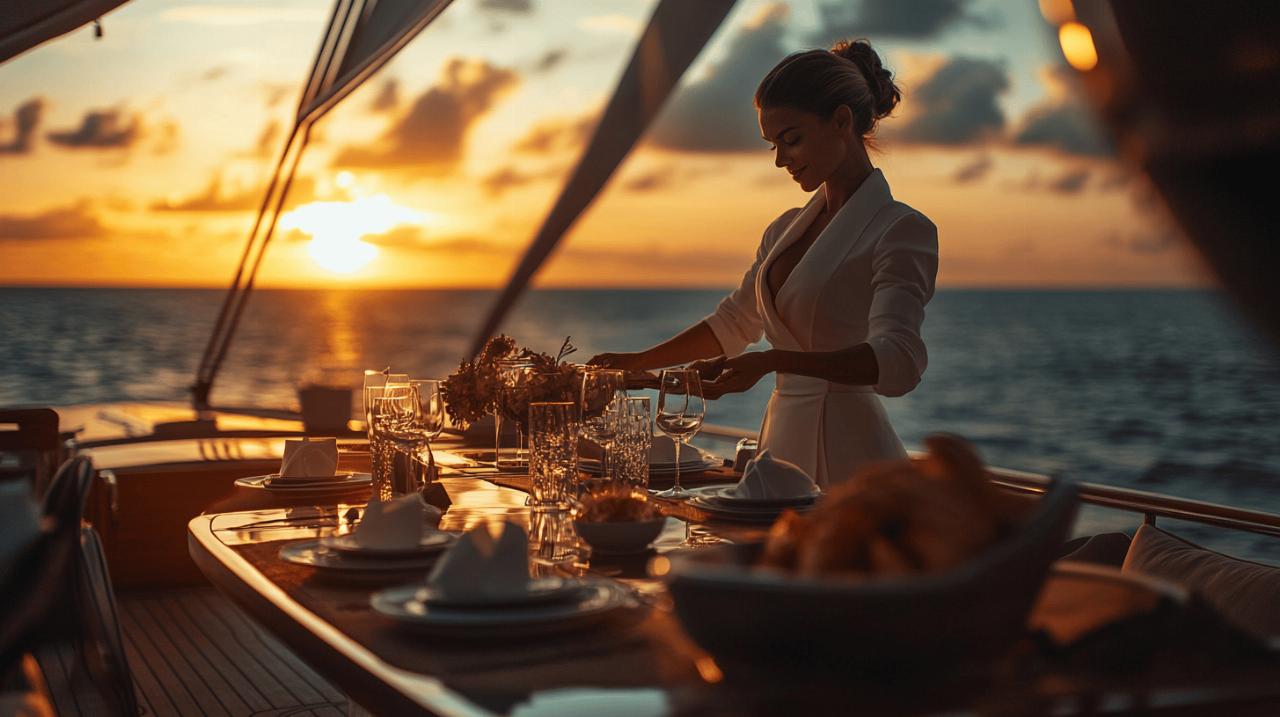The world of luxury yachting holds a certain mystique, a blend of opulence and adventure that draws many to consider a career on the water. For those with an eye for detail and a passion for impeccable service, the role of a yacht stewardess offers a unique opportunity to combine travel, hospitality, and life at sea. However, beneath the glamorous veneer lies a demanding profession that requires dedication, rigorous training, and a commitment to excellence. Understanding the realities of this career path is essential before embarking on this exciting journey.
Professional training and qualifications: building your maritime career foundation
Mandatory certifications and industry-recognised credentials
Entering the yachting industry as a stewardess is not simply a matter of presenting oneself with a polished appearance and a willingness to serve. The profession demands a solid foundation of formal training and recognised certifications that demonstrate competency in both service and safety. At the heart of these requirements lies the STCW certification, which stands for Standards of Training, Certification, and Watchkeeping for Seafarers. This internationally recognised qualification covers basic safety training, including fire fighting, first aid, and security duties, ensuring that all crew members are prepared to respond to emergencies at sea. Without this certification, securing a position aboard a superyacht is virtually impossible, as it is a legal requirement for anyone working on a vessel over a certain size.
Beyond the STCW, aspiring stewardesses benefit greatly from pursuing specialised courses tailored to the interior service sector. Training providers such as Flying Fish, based in Cowes on the Isle of Wight, offer comprehensive programmes that encompass everything from superyacht interior management to barista training. These courses provide hands-on experience and knowledge that align with the expectations of high-end yachting operations. Additionally, obtaining certifications in powerboat handling, VHF radio communication, and other RYA courses can enhance a candidate's profile, particularly for those considering dual-role positions that combine interior duties with deck responsibilities. The investment in these qualifications not only opens doors to employment but also signals to potential employers a serious commitment to professionalism and career development.
Specialised beverage service training for luxury yachting
One of the defining aspects of service excellence aboard a superyacht is the ability to deliver impeccable beverage service. This extends far beyond simply pouring a glass of champagne; it involves a deep understanding of wine inventory, cocktail preparation, and the nuances of serving premium spirits and beverages to discerning guests. Chief stewardesses and senior interior crew members often oversee wine menus and work closely with the chef to ensure that pairings complement the dining experience. Training in wine service techniques, including proper pouring, decanting, and temperature control, is essential for those aiming to excel in this field.
Barista training has also become increasingly important in the luxury yachting sector, as guests expect café-quality coffee prepared to their exact specifications. Whether it is a perfectly frothed cappuccino in the morning or an expertly crafted espresso after dinner, the ability to operate professional-grade coffee machines and understand the subtleties of different beans and brewing methods sets a stewardess apart. Furthermore, mock service training and role-playing exercises are invaluable tools for preparing crew members to handle a variety of service scenarios. These practical sessions allow stewardesses to practise table setting, master cutlery standards, and refine their ability to anticipate guest preferences before they are even voiced. Such preparation ensures that when guests step aboard, they experience seamless, personalised service that feels effortless yet is underpinned by meticulous training and attention to detail.
The Reality of Life Aboard: Understanding Working Conditions and Expectations
Daily Responsibilities and the Physical Demands of Yacht Service
Working as a yacht stewardess is far removed from the leisurely image that might first come to mind when imagining life at sea. The role is physically demanding and requires a high level of stamina and resilience. A typical day can stretch to twelve hours or more, with duties that encompass housekeeping, laundry, guest service, and maintaining spotless standards throughout the vessel. On yachts ranging from 35 metres to over 100 metres, the scale of the operation increases significantly, and the expectations for interior presentation become ever more exacting. Chief stews lead the interior team, managing not only the day-to-day service but also crew training, interior budgets, and coordination with other departments.
For those in junior positions, such as third stews or housekeeping stews, the focus is often on keeping guest and crew areas immaculate. This involves detailed cleaning, polishing, and ensuring that every surface, from marble countertops to stainless steel fixtures, gleams without a single fingerprint or smudge. Laundry duties are another critical component, particularly on larger vessels where a dedicated laundry stew is responsible for washing, ironing, and steaming guest and crew clothing, linens, and towels. The physical nature of the work, combined with the need to maintain a cheerful and professional demeanour at all times, can be challenging. Moreover, stewardesses must be adaptable and willing to take on additional responsibilities, whether that involves assisting the chef in the galley, supporting deck crew with exterior tasks, or stepping into a specialised role such as nanny stew or spa manager.
Crew Dynamics and Professional Standards in Confined Spaces
Living and working aboard a superyacht means sharing confined spaces with a small crew for extended periods, often while the vessel is cruising to remote locations or hosting high-profile guests. This environment requires exceptional interpersonal skills, reliability, and a strong sense of teamwork. Every member of the crew, from the captain to the newest deckhand, plays a vital role in ensuring the smooth operation of the yacht. Interior service training emphasises the importance of communication and coordination, as the success of guest relations and overall service excellence depends on the ability of the team to work cohesively.
Professional standards are paramount in this setting. Crew members are expected to uphold the highest levels of conduct, appearance, and discretion. Guests aboard luxury yachts often value their privacy and expect VIP treatment, which means that stewardesses must be attuned to individual preferences and cultural adaptation. Understanding the customs and expectations of guests from different backgrounds enhances the guest experience and demonstrates a level of service that goes beyond the ordinary. The role also demands a high degree of flexibility, as service customisation is often required to meet the unique requests of owners and charterers. Whether adjusting meal times to accommodate late-night entertainment or preparing specific table settings for a formal dinner, the ability to anticipate needs and deliver bespoke service is what distinguishes an exceptional stewardess from the rest.
Safety Protocols and Emergency Preparedness at Sea
Essential maritime safety knowledge for stewardesses
 While the focus of a yacht stewardess is primarily on guest service and interior management, safety at sea is a responsibility that every crew member shares. The maritime environment presents unique hazards, and preparedness for emergencies is a non-negotiable aspect of the profession. STCW basic safety training covers fundamental skills such as fire fighting, first aid, and survival techniques, all of which are crucial in the event of an incident aboard. Stewardesses must be familiar with the location and operation of fire extinguishers, life rafts, and emergency alarms, and they should be able to execute evacuation procedures swiftly and calmly.
While the focus of a yacht stewardess is primarily on guest service and interior management, safety at sea is a responsibility that every crew member shares. The maritime environment presents unique hazards, and preparedness for emergencies is a non-negotiable aspect of the profession. STCW basic safety training covers fundamental skills such as fire fighting, first aid, and survival techniques, all of which are crucial in the event of an incident aboard. Stewardesses must be familiar with the location and operation of fire extinguishers, life rafts, and emergency alarms, and they should be able to execute evacuation procedures swiftly and calmly.
In addition to these foundational skills, ongoing training and regular drills ensure that crew members remain sharp and ready to respond to any situation. This includes understanding the layout of the yacht, knowing where safety equipment is stored, and being able to assist guests in donning life jackets and reaching muster stations. For those in senior positions, such as chief stews, the responsibility extends to overseeing the safety readiness of the entire interior team and ensuring that all protocols are followed meticulously. The integration of safety training into daily routines reinforces the seriousness with which the yachting industry treats crew and guest welfare.
Crisis management and guest protection responsibilities
Beyond the standard safety protocols, yacht stewardesses must also be prepared for a range of crisis scenarios that could arise at sea or in port. Medical emergencies, for example, require a calm and decisive response. Some vessels employ nurse stews who combine medical care with interior duties, providing an added layer of security for guests and crew. However, all stewardesses should have a working knowledge of first aid and be able to administer basic care until professional medical assistance can be reached. This includes recognising the signs of serious conditions such as heart attacks, severe allergic reactions, or injuries sustained during onboard activities.
Guest protection also encompasses ensuring their comfort and well-being during adverse weather conditions or mechanical issues. Stewardesses must be vigilant about potential hazards, such as wet decks, loose items that could cause injury, or risks associated with rough seas. Reporting any maintenance issues or safety concerns to the captain or engineer promptly is part of the stewardess's duty of care. In addition, understanding onboard protocols and having a clear chain of command ensures that in moments of crisis, everyone knows their role and can act without confusion. The ability to remain composed under pressure and to reassure guests while taking necessary action is a hallmark of professionalism that defines the best in the industry.
Mastering beverage service excellence in luxury yachting
Premium cocktail preparation and wine service techniques
The art of beverage service is a cornerstone of the luxury yachting experience, and mastering it requires both technical skill and an appreciation for the finer points of hospitality. Guests aboard superyachts expect nothing less than perfection when it comes to the drinks they are served, whether that is a classic martini, a vintage Bordeaux, or a meticulously crafted espresso martini. Understanding the principles of mixology, including the balance of flavours, the quality of ingredients, and the presentation of cocktails, is essential for any stewardess aiming to excel in this area. Training in cocktail preparation often involves learning the recipes for a wide range of classic and contemporary drinks, as well as the ability to adapt and create bespoke concoctions based on guest preferences.
Wine service is another critical component that demands both knowledge and finesse. A thorough understanding of wine inventory, including the provenance and characteristics of different varietals, enables a stewardess to make informed recommendations and pairings. The physical techniques of wine service, such as proper decanting, pouring without spillage, and maintaining the correct serving temperature, are all skills that must be practised and perfected. On larger yachts, the wine menu is curated in collaboration with the chief stewardess and the chef, ensuring that each course is complemented by a suitable selection. Mock table settings and role-playing exercises provide opportunities to rehearse these techniques, allowing crew members to build confidence and consistency in their service delivery.
Anticipating guest preferences and delivering bespoke service
The true measure of excellence in beverage service lies not just in technical proficiency but in the ability to anticipate and personalise the experience for each guest. Observing and remembering individual preferences, from a guest's favourite gin to their preferred coffee strength, transforms a standard service into something memorable and distinctive. This level of attentiveness requires keen observation, excellent memory, and a genuine interest in providing exceptional hospitality. Chief stewardesses often emphasise the importance of learning about guest cultures and adapting service to align with their expectations and habits. For example, understanding the tea traditions of guests from certain regions or the etiquette surrounding toasting in various cultures can greatly enhance the guest experience.
Delivering bespoke service also involves creating an atmosphere that feels both effortless and attentive. Guests should never feel that their needs are a burden; rather, every request should be met with enthusiasm and a willingness to exceed expectations. This philosophy is at the heart of what defines world-class service aboard superyachts. Training programmes often include service scenarios and mock meals where crew members practise these principles in a simulated environment. The feedback and refinement that come from these exercises help to ensure that when the time comes to serve real guests, the service is flawless. Ultimately, the goal is to give guests more than they expect without overwhelming them, treating everyone with equal respect and making each individual feel like a VIP.







